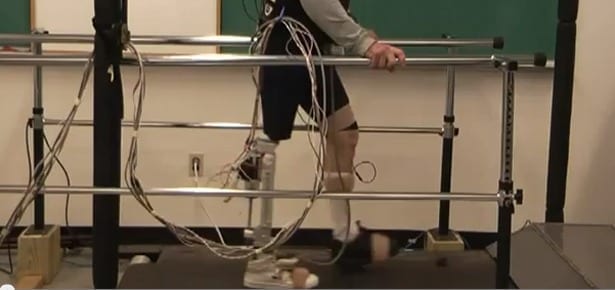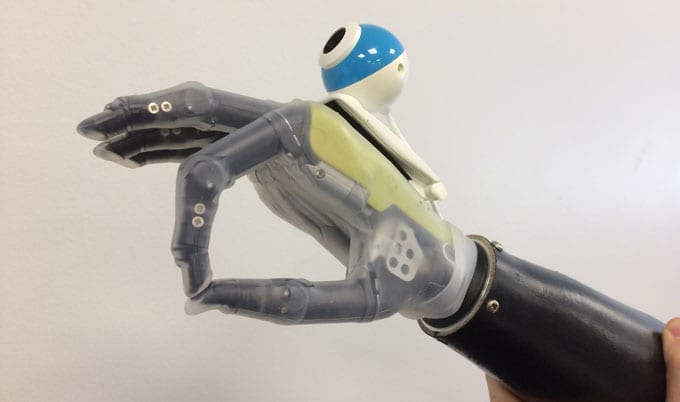
“Our goal is to improve mobility for people using prosthetics”
Most people don’t think about the difference between walking across the room and walking up a flight of stairs. Their brains (and their legs) automatically adjust to the new conditions. But for people using prosthetic legs, there is no automatic link between their bodies and the prosthetics that they need to negotiate the new surroundings.
Researchers from NC State and the University of Houston (UH) are hoping to change that with a new four-year, $1.2 million collaborative project funded by the National Science Foundation (NSF).
“Our goal is to improve mobility for people using prosthetics, lay the groundwork for a new generation of prosthetic devices and improve our understanding of how brain signals and neuromuscular signals are coordinated,” says Helen Huang, principle investigator (PI) of the NSF grant and an associate professor of biomedical engineering at NC State and UNC.
In recent years, researchers have developed powered prosthetic devices that use internal motors to improve the motion of the artificial limb. The goal of the NSF project is to improve the connection between the prosthetic and the person using it.
Huang’s team will be using sensors to pick up the neuromuscular control signals from residual muscles in the area where the prosthetic is connected to its user. Huang’s goal is to develop an algorithm that translates those neuromuscular signals into machine language that will control the powered prosthesis – making it easier for the user to move seamlessly from standing up, to walking across the room, to climbing the stairs.
Huang’s team also plans to build a prototype power prosthesis that incorporates the new technology. This aspect of the research builds on Huang’s previous experience in designing and fabricating power prosthetics.
The Latest Bing News on:
Prosthetic devices
- How two Kenyan school dropouts made prosthetic arms for people with disabilitieson May 2, 2024 at 2:53 am
Two young Kenyan inventors have invented bio-robotic prosthetic arms from waste materials to help improve the lives of people without limbs.
- Students invent 3D-printed prosthetic arms and explore bee pollination at national STEM competitionon April 30, 2024 at 3:44 pm
There's research on everything from overcoming bias in artificial intelligence to the creation of a $40 3D-printed prosthetic arm. "You can push in a button, lengthen it and it locks back in place," ...
- Artivion presents double win at AATS for aortic deviceson April 30, 2024 at 4:42 am
Artivion has presented positive data from two clinical trials evaluating its On-X aortic valve and AMDS prosthesis device.
- Archaeologists Discover 'Unique' Artificial Body Part in 18th Century Skullon April 29, 2024 at 2:07 pm
The "unusual" object was made with great craftsmanship and would likely have significantly improved the patient's quality of life.
- Scientists Make Breakthrough in Chronic Pain Treatmenton April 26, 2024 at 7:53 am
Scientists have developed tiny robotic nerve "cuffs" to diagnose and treat neurological disorders. The flexible devices offer a safer, minimally invasive alternative to today's diagnostics and could ...
- BEST & BRIGHTEST: A passion to design prosthetics began earlyon April 25, 2024 at 4:00 am
Prosthetics, biomedical engineering and degenerative myelopathy are not the kinds of things most 10-year-olds think about, but eight years ago, these thoughts triggered a passion for Lewis-Palmer High ...
- Blue Arbor wins FDA breakthrough nod for neuromuscular interfaceon April 24, 2024 at 7:25 am
Blue Arbor Technologies announced today that it received FDA breakthrough device designation for its Restore neuromuscular interface system.
- Blue Arbor Technologies Receives FDA Breakthrough Device Designation and TAP Enrollment for the RESTORE™ Neuromuscular Interface Systemon April 24, 2024 at 6:06 am
FDA grants Breakthrough Device Designation to Blue Arbor RESTORE System designed to enable naturalistic function for those with upper limb prosthetics ...
- Healthon April 22, 2024 at 5:00 am
Giebel, director of the VA Rocky Mountain network, which includes the Aurora hospital, confirmed The Denver Post’s reporting from November that first uncovered the prosthetics ...
- Voice Prosthesis Devices Market Size, Share, Growth Statistics, Latest Trends, and Forecast 2024 to 2032on April 18, 2024 at 9:48 pm
Report Ocean recently added a research report on “Voice Prosthesis Devices Market”. The report includes an extensive analysis of the market’s characteristics, COVID-19 impac ...
The Latest Google Headlines on:
Prosthetic devices
[google_news title=”” keyword=”World Wide Web” num_posts=”10″ blurb_length=”0″ show_thumb=”left”]
The Latest Bing News on:
Power prosthetics
- Patriarch Kirill accuses Ukrainians of religious persecutionon May 2, 2024 at 5:00 pm
Truth will triumph, and a just peace be established by the power of Christ the Saviour ... a co-operation agreement with a charity in the United States which provides prosthetics and rehabilitation ...
- Elisabeth Moss Details Angelina Jolie vs. Winona Ryder ‘Camps’ on ‘Girl, Interrupted’ Seton May 1, 2024 at 9:57 am
Elisabeth Moss recalled how the power dynamics of Girl, Interrupted played out even after “cut!” was yelled. Moss, 41, played Polly “Torch” Clark, a burn victim with schizophrenia, in the 1999 film, ...
- First Look presents a fine look at the future (or is it now?) with THE A.I. AT DELPHI.on May 1, 2024 at 7:26 am
THE A.I. AT DELPHI, a new play by Bella Poynton, directed by Jeffrey Coyle, presented by First Look Buffalo, starring: Melinda Capeles, Lisa Ludwig, Jon May, and Anthony ...
- Fact-Check: Were These Fake Fingers Used for Voting Fraud in West Bengal? No!on May 1, 2024 at 4:20 am
Fact-Check: A set of photos showing fake fingers has gone viral with the false claim that they show fake fingers which were used in West Bengal, so voters could cast their vote multiple times and ...
- Every movie and show coming to Netflix in Mayon May 1, 2024 at 4:00 am
Even with Netflix’s recommendation algorithm serving you new movies, new TV shows, and original programming tailored to your viewing habits, the streaming service’s fire hose of content makes what’s ...
- Disney+ now showing sci-fi classic released 50 years after landmark originalon April 30, 2024 at 9:00 pm
When Rise first came out it was greeted with positive reviews and reactions – its Rotten Tomatoes critics' score is currently sat at 82% – but its reputation has grown over time, while its two sequels ...
- Students invent 3D-printed prosthetic arms and explore bee pollination at national STEM competitionon April 30, 2024 at 3:44 pm
There's research on everything from overcoming bias in artificial intelligence to the creation of a $40 3D-printed prosthetic arm. "You can push in a button, lengthen it and it locks back in place," ...
- Based on C.J. Sansom’s novel, ‘Shardlake’ sets a murder mystery in Tudor Englandon April 30, 2024 at 1:48 pm
Based on the first of C.J. Sansom's Tudor-era murder mystery novels, "Shardlake," premiering Wednesday on Hulu, follows a lawyer turned reluctant detective.
- Best G3 Monster High Dollson April 30, 2024 at 11:00 am
From Clawdeen Wolf 's fierce outfits to Draculaura's hauntingly beautiful bat-themed ensemble, the G3 Monster High dolls are a far cry from the norms. Our guide will dissect the best G3 Monster High ...
- Tether Acquires Stake in Brain-Computer-Interface Firm Blackrock Neurotechon April 30, 2024 at 5:42 am
Tether, which claims to be one of the largest companies in the digital asset industry, announced that it has made a strategic investment.
The Latest Google Headlines on:
Power prosthetics
[google_news title=”” keyword=”power prosthetics” num_posts=”10″ blurb_length=”0″ show_thumb=”left”]










